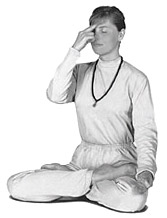Pranayama` is a compound word comprising of `prana` and `yama`. It also means maintenance of prana(the energy in the body) in a healthy state at all ages and in all circumstances.
Prana makes the body function, creating strength and power. It acts as a bridge connecting matter and consciousness, helping in discovering prakriti (nature) and chitta (soul). It uncovers the veil (ahamkara) between prakriti and purusha (man), so that matter (bhutas), energy and absolute awareness become one.
By controlling the motion of the lungs or respiratory organs, we can control the Prana that is vibrating inside. By control of Prana, the mind can be easily controlled. Deep breathing has a profound effect on the kundalini.
 Pranayama, the science of yogic breathing, was not discovered unnecessarily. Through long experiments and investigations and long-term experiences it was known that a great deal can be accomplished with the help of breathing and its hammering on the kundalini. A lot can be done through deep and fast breathing.
Pranayama, the science of yogic breathing, was not discovered unnecessarily. Through long experiments and investigations and long-term experiences it was known that a great deal can be accomplished with the help of breathing and its hammering on the kundalini. A lot can be done through deep and fast breathing.
Breathing hits the kundalini, the basic center of energy. All the centers, which you call chakras, are nothing but halting places for the kundalini on its journey`s way. These are the centers through which the kundalini passes.
Ordinarily, there are a number of such centers. But broadly speaking there are seven important centers where the kundalini, while moving up and down, is likely to halt and rest for awhile. It will have its effect when it comes in contact with them, and its first effects will be felt on the center that is your most active center as such.
Accordingly a change, a transformation of the personality begins simultaneously. You will begin to know that you are changing; you are not the same person that you were up to now.
As the various centers are hit and activated, new dimensions of your life will begin to unfold and manifest themselves. And when all the centers are active together - that is, when energy will flow through them all uniformly - then for the first time we will live a whole life; we will live totally.
Practicing Pranayama: When you practise the following, concentrate on the Muladhara Chakra at the base of the spinal column, which is triangular in form and which is the seat of the Kundalini Shakti. Close the right nostril with your right thumb. Inhale through the left nostril till you count 3 Oms slowly. Imagine that you are drawing the Prana with the atmospheric air. Then close the left nostril with your little and ring fingers of the right hand. Then retain the breath for 12 Oms. Send the current down the spinal column straight into the triangular lotus, the Muladhara Chakra. Imagine that the nerve-current is striking against the lotus and awakening the Kundalini. Then slowly exhale through the right nostril counting 6 Oms. Repeat the process from the right nostril as stated above, using the same units, and having the same imagination and feeling. This Pranayama will awaken the Kundalini quickly. Do it 3 times in the morning and 3 times in the evening. Increase the number and time gradually and cautiously according to your strength and capacity. In this Pranayama, concentration on the Muladhara Chakra is the important thing. Kundalini will be awakened quickly if the degree of concentration is intense and if the Pranayama is practised regularly.
It is impossible to admire this wonderful Pranayama adequately. It is the magic wand for attaining perfection very quickly. Even a few days` practice will convince you of its remarkable glory. Start from today, this very moment and experience the joy.




















